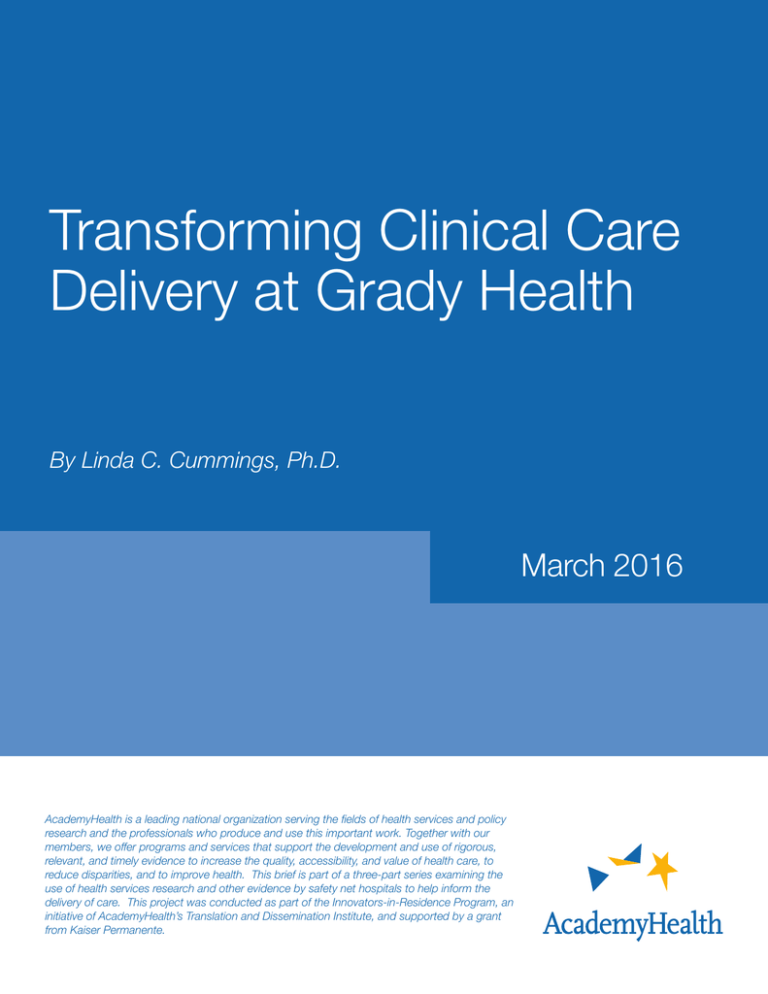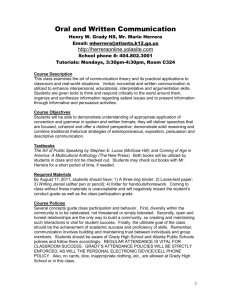Transforming Clinical Care Delivery at Grady Health March 2016
advertisement

Transforming Clinical Care Delivery at Grady Health By Linda C. Cummings, Ph.D. March 2016 AcademyHealth is a leading national organization serving the fields of health services and policy research and the professionals who produce and use this important work. Together with our members, we offer programs and services that support the development and use of rigorous, relevant, and timely evidence to increase the quality, accessibility, and value of health care, to reduce disparities, and to improve health. This brief is part of a three-part series examining the use of health services research and other evidence by safety net hospitals to help inform the delivery of care. This project was conducted as part of the Innovators-in-Residence Program, an initiative of AcademyHealth’s Translation and Dissemination Institute, and supported by a grant from Kaiser Permanente. Transforming Clinical Care Delivery at Grady Health Genesis of this Brief: This profile is based on interviews conducted in winter 2015 with Leon Haley, M.D., Executive Associate Dean of Clinical Services for Grady Memorial Hospital at Emory University School of Medicine; and Anekwe Onwuanyi, M.D., Chief of Cardiology, Morehouse University School of Medicine. This brief is a “snapshot in time” intended to illustrate how a safety net hospital and its partners used research and other evidence to help inform program development. It is not intended to be a comprehensive analysis of a particular program or partnership. Transforming Clinical Care, an initiative at Grady Health to reduce readmissions in heart failure patients, was awarded the 2013 Gage award by America’s Essential Hospitals (AEH) for excellence in improving the quality of patient care. The Gage awards recognize successful and creative programs among AEH member hospitals that provide better care to vulnerable patients. Grady Health in Atlanta is the largest health system in Georgia and one of the largest public hospital systems in the nation. About Grady Health System The residents of Atlanta, Georgia, have long valued Grady Health and hold the hospital in special regard. Founded in 1892 by Henry W. Grady, editor of the Atlanta Constitution, as a hospital to provide high-quality health care for the city’s poor, Grady Health is today one of the nation’s largest public health systems. Over the years, Grady has become an essential part of the health care system in Atlanta, serving as a teaching hospital for two major medical schools, Emory University School of Medicine and Morehouse University School of Medicine; providing one of the five Level 1 trauma centers in the state; and offering a full range of specialized medical services to the entire community. In 2011, Grady Health cared for over 600,000 patients in its 950-bed hospital, in its outpatient services and six neighborhood clinics, and in its emergency department. In 2007, Grady faced a financial crisis that was long in the making but finally threatened the hospital’s viability. As Grady struggled with a $60 million deficit and, according to news accounts, was barely able to make payroll, the response to the crisis among leading Atlanta residents illustrated Grady’s importance to the community. As the New York Times noted in 2008, “To generations of Georgians, this city is unimaginable without Grady.”1 In 2008, a group of public and private sector and community leaders organized a restructuring of the hospital to create the nonprofit Grady Memorial Hospital Corporation. Following the restructuring, the Robert W. Woodruff Foundation led philanthropic investment in the hospital system with a pledge of $200 million over four years. The infusions of financial support and new leadership under CEO John Haupert brought stability to Grady, along with a rebranded hospital system, the expansion and updating of facilities, and outreach to attract more privately insured patients. Grady’s central commitment to health care for the city’s underserved remains unchanged. 2 Although now on somewhat improved financial footing, Grady continues to face threats posed by an inadequate payment base. Grady’s largest payer is Medicaid, which reimburses at a rate significantly below the hospital’s costs. Medicare and a small percentage of privately insured patients constitute the rest of Grady’s payment base, and the hospital continues to deliver millions of dollars annually in uncompensated indigent and charity care. The state of Georgia opted out of Medicaid expansion under the Affordable Care Act (ACA), and uninsured patients continue to choose Grady for their care because of its role as the safety net hospital for the Atlanta region. The uninsured generally visit the emergency department, where the cost of care is highest. Transforming Clinical Care Delivery: Grady Heart Failure Program In 2010, Grady Health established a heart failure clinic under the leadership of Dr. Anekwe Onwuanyi, chief of cardiology at Morehouse University School of Medicine. For the previous 10 years, Grady’s cardiology department had worked on the issue of heart failure, developing educational programs for patients, organizing patient and family seminars, and holding a major annual conference with caretakers. In 2010, several factors contributed to a renewed effort to reduce Grady’s patient readmissions from heart failure. Chief among those factors were the need to improve patient care in order to reduce persistently high readmission rates for heart failure, the adoption of an electronic medical record system, and impending penalties under the ACA for heart failure readmissions. It was a task force at Grady led by Dr. Onwuanyi and including senior members of the hospital administration, cardiology faculty, providers, and patients that provided the impetus for the heart failure clinic. From the outset, the Grady administration has supported the effort to address persistent heart failure. In fact, the administration’s unflagging support has been essential to sustaining momentum to improve and expand the heart failure clinic. The administration’s interest in a comprehensive approach to cardiac care stemmed from two major goals: to improve the quality of care for heart failure patients and to decrease readmissions and readmission penalties. The heart failure readmissions rate was a widely acknowledged problem throughout the hospital, but the heart failure task force needed to undertake research to substantiate the investment in a heart failure clinic. The task force believed that a comprehensive review of Grady’s patient data, clinical studies, and the practices at other hospitals March 2016 Transforming Clinical Care Delivery at Grady Health would provide the foundation for a new approach to cardiac care at Grady. At the core of their approach was a commitment to addressing heart failure comprehensively, incorporating selected best practices and, above all, tailoring their efforts to the characteristics of the Grady patient population. Understanding Trends in Heart Failure Readmissions at Grady At the outset, Dr. Onwuanyi reviewed the heart failure readmissions literature in the major clinical journals but noted that most studies did not involve patients similar to Grady’s; most of the recommendations were tailored to a middle-class, suburban population. Members of the task force also studied heart failure programs at other institutions and received helpful advice, especially about challenges and potential pitfalls. Dr. Onwuanyi spoke to the chiefs of cardiology at New York University Hospital and locally at Emory University and Piedmont hospitals in Atlanta, where Grady sends many patients requiring advanced care. He also contacted colleagues at public institutions similar to Grady, including Parkland Memorial in Dallas and Bellevue in New York City, both large metropolitan safety net hospital systems with comparable patient populations. Mid-level Grady staff consulted with Parkland’s Epic team to learn about use of Parkland’s electronic medical record system specifically for heart failure patients. To develop a better understanding of the reasons for heart failure readmissions at Grady, Dr. Onwuanyi, with the assistance of a research associate, conducted a retrospective analysis of patients readmitted within 30 days for heart failure from November 2009 to October 2010. During the study period, 14.2 percent of patients with a heart failure diagnosis were readmitted within 30 days. Of the readmitted patients, 70 percent experienced worsening heart failure, particularly the elderly. The retrospective study pointed to a set of patient issues that were contributing to the high number of readmissions for heart failure. Notably, patients ran out of the one-week supply of medications they received at discharge and were unable to refill their prescription in a timely manner. As a result, many patients went without medication for extended periods, causing their condition to worsen and often lead to readmission. The task force worked with Grady’s pharmacy department to arrange for patients to receive a month’s supply of medication at discharge, thus allowing sufficient time for prescription refills. As the task force reviewed post-discharge processes, it found that it was often difficult to ensure that patients saw a physician a week after discharge. Even with a scheduled appointment, patients sometimes did not show up. In addition, the study revealed that 3 many readmitted patients were unable to read and/or unable to understand the patient information literature on heart failure. Many patients were reluctant to acknowledge their inability to understand the written material. In response, when the heart failure clinic was established, it created a survival guide that provides post-discharge care instructions at a grade 8 reading level illustrated with instructional pictures. How the Grady Heart Failure Program Operates Given that Grady is an academic medical center, the Emory and Morehouse University schools of medicine work collaboratively to operate the heart failure clinic, providing the clinic’s attending physicians. In addition, the clinic is staffed by three mid-level providers who are nurse practitioners. Most admissions at Grady, as at other safety net hospitals, take place through the emergency department. A small number of patients in the heart failure clinic are referred from other clinics. Grady’s electronic medical record (EMR) system makes it possible to track heart failure patients across the hospital and to target patients at particular risk for readmission. Each morning, the EMR system also allows the mid-level providers to see all patients admitted to the hospital overnight for heart failure. Once a patient is admitted to the heart failure clinic, a mid-level provider in the clinic works with the patient and the primary care team to identify the patient’s risk factors for readmission. The midlevel provider pays particular attention to the patient’s transition from hospital to home, confirming that the patient has sufficient medication and understands post-discharge instructions. The midlevel provider also follows up directly with the patient at three days post-discharge to make sure that he or she is following discharge instructions, has the appropriate medication on hand, and is progressing satisfactorily. The Grady Heart Failure Clinic Process 1. A heart failure patient is admitted to Grady through the emergency department. 2. Patient is seen by a mid-level practitioner from the heart clinic within 24 hours of admission. 3. Clinic staff educates the patient about how to manage heart failure. 4. Clinic staff works with the primary admitting team to identify the patient’s risk factors for readmission. 5. The assigned mid-level provider follows the patient during the transition from hospital to home. 6. The mid-level provider follows up with each patient by telephone post-discharge. 7. Patients are seen in the clinic within seven days of discharge. March 2016 Transforming Clinical Care Delivery at Grady Health The clinic does not attempt to serve as a medical home and instead focuses on treating the patients’ heart failure and providing continuing education to optimize the treatment initiated during the inpatient stay. The clinic provides a setting in which the patient sees the same medical staff over the entire course of treatment. The clinic works with patients to titrate medications to allow for the maximum tolerable and effective dosage. Once the patient’s medications are regulated and the patient has received postdischarge follow-up, the patient is discharged to a medical home, a primary care doctor or the general cardiology clinic. As Emory University School of Medicine’s Executive Associate Dean of Clinical Services for Grady, Dr. Leon Haley is responsible for the clinical, administrative, and educational footprint of the approximately 1,000 Emory faculty, residents, and staff at Grady on a given day. Among other roles, Dr. Haley is also chief medical officer of the Emory Medical Care Foundation. From this perspective, Dr. Haley notes that there are currently about 445 active projects at Grady, of which almost 80 percent are Emorybased. A research oversight committee at Grady provides coordination but lacks the resources needed to support research design or study implementation, although Emory works closely with Grady to provide some research support. A working group meets monthly to identify problems in clinic operations and to resolve them with the relevant hospital staff. Working group participants represent various hospital departments, including pharmacy, the inpatient cardiac unit, and psychiatry. A dedicated social worker, assigned to the heart failure clinic, attends the monthly meeting, along with members of the Grady administration and the occasional invited speaker representing other aspects of cardiology care. relying on findings in the literature. This approach was underscored when Dr. Onwuanyi attempted to apply the LACE index, a severity scoring tool widely used to predict high risk for readmission among heart failure patients.3 Dr. Onwuanyi found that the LACE index, often cited in heart failure literature, was not a sufficient predictor of readmissions for Grady patients. The monthly meetings help inform the daily operation of the clinic but are also instrumental in maintaining the focus on the urgent need to reduce heart failure readmissions, which precipitated establishment of the clinic in the first place. The director of the hospital’s Clinical Decision Unit (CDU) participates in the monthly meetings and works closely with the heart failure clinic, helping coordinate care across Grady including managing heart failure patients who frequently visit the emergency department for care. At the outset of their retrospective analysis of heart failure readmissions data, Dr. Onwuanyi and his research assistant found no correlation between the LACE index and Grady patients in the study. Some of the factors used in the LACE model applied to Grady patients, but the model was inadequate as a predictor because it did not include factors prevalent in the safety net patient population. Grady patients often lack health insurance, cannot afford medications, or experience substance abuse. Impact of the Clinic on Reducing Heart Failure Readmissions at Grady Grady admits about 1,200 patients annually for heart failure. In addition to inpatient referrals, primary care and other clinics refer patients to the heart failure clinic. Initially, an insufficient number of personnel were available to staff the clinic, causing access problems for patients. With support from the administration, Grady increased the number of mid-level providers who see patients, from one nurse practitioner to three full-time nurse practitioners who staff the clinic four days a week. Since the clinic began operating, it has seen about 3,000 patients. On a monthly basis, each midlevel practitioner sees about 8 patients per session and about 100 per week. In addition, since the clinic’s inception, 78 percent more patients keep their post-discharge appointments, and the 30-day admission rate has decreased by 31 percent and emergency department visits by 37 percent.2 Even though Dr. Onwuanyi and colleagues long suspected the lack of correlation between standard readmission predictors and Grady patients, their retrospective analysis was needed to confirm the importance of a Grady-specific approach. This analysis identified a set of patient factors unique to Grady and to other safety net hospitals that were not studied in the heart failure literature. As it turned out, the retrospective analysis was an “eye-opener” that confirmed the distinctiveness of the Grady patient population. Consequently, as the team developed the heart failure clinic, it relied on its own data and adapted as appropriate findings from the literature and other sources. Use of Research in Designing the Grady Heart Failure Clinic The task force believed from the outset that a successful intervention to reduce heart failure readmissions was dependent on an understanding of Grady’s patient population rather than merely 4 Research Challenges and Opportunities Lack of Research Relevant to the Safety Net Population Dr. Haley noted that the lack of research on care for safety net patients is not limited to heart failure but extends to many other conditions, to the causes of hospitalization, and to effective strategies for outpatient follow-up. Given the dearth of literature on the safety net population, the literature’s recommended interventions often do not apply to patients in hospitals such as Grady. As both Dr. Haley and Dr. Onwuanyi agreed, one of the biggest challenges facing them is finding the resources at Grady needed to initiate research on safety net patients. Ten or 15 years ago, in an era with March 2016 Transforming Clinical Care Delivery at Grady Health only paper health records, it would have been very difficult to track research across Grady. The infrastructure today is somewhat improved given the adoption of an EMR, but not strong enough to support a robust, comprehensive effort. In addition, Grady Health System is an independent organization aligned with two medical schools with their own research functions. Grady has recently begun to build its own internal resources with the creation of the position of director of grants who works to secure funding to operationalize ideas into projects. Dr. Onwuanyi also noted that the help of a research assistant was instrumental in getting the heart failure clinic off the ground in a timely manner. Without such assistance, Dr. Onwuanyi would have conducted the retrospective data analysis only as he was able to in combination with his clinical work. The retrospective data analysis provides background information that serves as reference points to measure gains and assess changes to patients and to Grady. The heart failure program would probably have been established at some point but likely would have faced impediments in efforts to refine the program or to assess its impact. Where Research Could Help With the heart failure program now operating for almost five years, Dr. Onwuanyi has seen “phenomenal” changes in the clinic patients who have become engaged in their own care. In Dr. Onwuanyi’s view, this transformation in the heart failure clinic patients is one area of needed study that could have potentially major significance for the care of safety net patients in general. In the past, providers simply assumed that patients did not care about improving their health. The clinic staff has found, however, that the clinic’s patient contact and individualized attention have yielded improvements that extend beyond a reduction in readmissions for heart failure. Over time, patients initiate calls to their mid-level providers rather than wait for outreach. With their one-on-one contact with patients in the clinic, providers have witnessed a transformation in the lives of those patients who begin to manage areas of their lives beyond cardiac care. Further research to understand this transformation 5 could offer important insights into managing the care of safety net patients across several chronic conditions. About the Author Linda C. Cummings, Ph.D., of Health Services Research LLC, provides research and program development consultation focused on the health status and health care of underserved populations. Dr. Cummings was formerly Vice President for Research at America’s Essential Hospitals, where she directed the Essential Hospitals Institute. In that capacity, she developed the organization’s research agenda around system redesign, quality performance and improvement in patient care, health disparities, and the financial and operational characteristics of safety net hospitals. Dr. Cummings served as an Innovator-in-Residence at AcademyHealth from January to March of 2015. Suggested Citation Cummings LC. “Transforming Clinical Care Delivery at Grady Health,” AcademyHealth, March 2016. Endnotes 1. Dewan S, Sack K. A safety-net hospital falls into financial crisis. The New York Times; 2008 Jan 8. Available from: http://www.nytimes.com/2008/01/08/ us/08grady.html?pagewanted=all&_r=0. 2. Data from 2013; Dr. Onwuanyi noted that, owing to limited research support, there is no capacity for ongoing data analysis. Instead, the program team looks periodically at the statistics, which, on average, indicate sustained gains. 3. LACE Index: Patient scores on admission and readmission using the following parameters: •Length of stay •Acuity of the admission •Comorbidities •Emergency department visits in previous six months Wang H, Robinson R, Johnson C, Zenarosa N, Jayswal R, Keithley J, Delaney K. Using the LACE index to predict hospital readmissions in congestive heart failure patients. BMC Cardiovasc Disord 2014;14(97). doi:10.1186/1471-2261-14-97 March 2016





